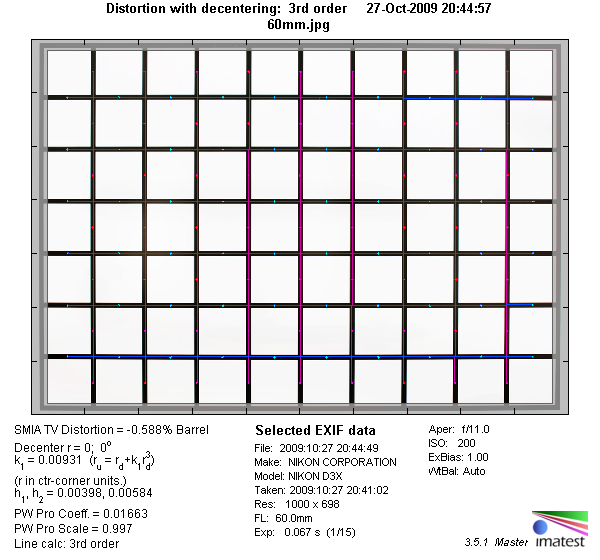|
Tamron AF 60mm f/2 SP Di II LD [IF] Macro - Review / Test Report - Analysis |
|
Lens Reviews -
Nikon / Nikkor (APS-C)
|
|
Page 2 of 3

Distortion
With just short of 0.6% the lens shows a slight amount of barrel type distortion. This is a little more than what one would expected from a fixed focal macro lens, however for most usage scenarios this can still be regarded as distortion-free under field conditions (unless for really demanding work like reproduction shots).

The chart above has a real-world size of about 120x80cm.
Vignetting
Being an APS-C lens, the Tamron is expected to show some vignetting wide open. A light falloff towards the corners of 1.13 EV is clearly visible in the images, but stopping down helps to reduce vignetting. From f/4 onwards it's no longer field-relevant.

MTF (resolution)
Macro lenses usually are very sharp and the Tamron 60 is no exception to this rule. In the image center, the resolution figures are excellent wide open down to f/11. The borders deliver very good sharpness throughout most of the tested aperture range. The extreme corners follow one step behind with good resolution wide open and very good sharpness at f/2.8 and beyond.
Beyond medium aperture settings diffraction is a limiting factor, but the lens manages to maintain a very high level of sharpness down to its minimum aperture of f/22. It is worth to mention that this latter aspect is odd - the lens performs actually "way too good" at f/22 leading to the conclusion that the effective aperture is actually bigger at small aperture settings, because diffraction effects are usually MUCH more pronounced beyond f/16. The tested sample (multiple ones actually) initially showed an underexposure problem which could support this theory. However, even after successful calibration of the aperture by Tamron the resolution results fully stopped down dropped only slightly (compared to our initial measurement) and still are on a much higher level than expected. Note that the behavior is also different on Canon EOS where the aperture is controlled electronically rather than by a potentially less accurate aperture lever.
Please note that the MTFs charts below represent the performance near infinity focus. For the time being macro performance tests are not possible.
Please note that the MTF results are not directly comparable across the different systems!
Below is a simplified summary of the formal findings. The chart shows line widths per picture height (LW/PH) which can be taken as a measure for sharpness.
If you want to know more about the MTF50 figures you may check out the corresponding Imatest Explanations
Chromatic Aberrations (CAs)
The amount of lateral CAs (color shadows at harsh contrast transitions) is a bit higher than one would expect from a prime lens. With values around 1 to 1.1 pixels at the image borders throughout most of the aperture range they are no show stopper, though. In addition, CAs can easily be removed in post processing and some of the newer Nikon DSLRs already do this in camera (if you shoot JPG).

Bokeh
Given the large aperture, the lens qualifies to be used for portraits or similar shots, where subject separation is required. For this kind of shots the quality of the bokeh (the out of focus areas) is of major interest.
Except some nervousness in front of the focus field (which is not really field-relevant) the Tamron shows very smooth bokeh and a pleasing softness in out of focus areas. Background highlights show a cat's eye shape wide open towards the image borders, but are rendered circular from f/4 onwards.

Bokeh Fringing
Bokeh fringing (non-coinciding focal planes of the various colors) is a common issue with relatively fast glass. As you can
notice below, the halos have different colors - magenta (red + blue) in front of the focus point
and green beyond.
As expected, the lens shows a moderate level of bokeh fringing wide open and stopping down helps to reduce the issue considerably. Truly "apochromatic" lenses don't show LoCAs but these lenses are very rare especially
below 100mm.
|